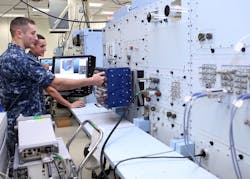Lockheed Martin to build 28 eCASS test and measurement systems to keep avionics and weapons systems working
LAKEHURST, N.J. – Test and measurement experts at Lockheed Martin Corp. will provide 28 eCASS advanced combat avionics test instruments under terms of a $95.3 million order announced Tuesday.
Officials of the Naval Air Warfare Center Aircraft Division in Lakehurst, N.J., are asking engineers at the Lockheed Martin Rotary and Mission Systems segment in Orlando, Fla., to build 28 electronic Consolidated Automated Support Systems (eCASS).
The eCASS equipment is designed to help sailors and Marines to troubleshoot and repair aircraft assemblies and return the avionics to service quickly. The test and measurement systems are for aircraft carriers, amphibious assault ships, or at aviation land bases.
The order also involves related equipment and data in support of avionics and weapon systems across several aircraft carriers and land sites for the Navy and U.S. allies.
Related: Test and measurement: the right results at the right time
The eCASS test equipment is replacing the Navy's legacy CASS test equipment originally fielded in the early 1990s. CASS is the Navy’s standard automatic test equipment family supporting electronics on naval aircraft.
The first eCASS station went to the Navy in February 2014 to support all the aircraft in the Navy’s fleet, extending to new weapons systems such as the F-35 Lightning II joint strike fighter. Lockheed Martin won a $103 million low-rate initial production (LRIP) contract in January 2014 for the first 36 eCASS test and measurement stations.
The eCASS station is the workhorse for avionics repair across the naval aviation enterprise, Lockheed Martin officials say. The test gear helps aircraft maintenance technicians return equipment to readiness status quickly and efficiently. Compatibility with legacy CASS stations preserves the Navy’s investment in more than 550 test program sets supporting 750 avionics components.
The eCASS systems helps test avionics and weapon systems for AV-8B Harrier jump jet; C-2 Greyhound carrier on-board delivery aircraft; E-2D Advanced Hawkeye radar surveillance aircraft; EA-6B Prowler and, EA-18G Growler electronic warfare aircraft; F/A-18A/B/C/D/E/F jet fighter-bombers; H-60R/S helicopters; T-45 Goshawk trainer jet; and V-22 tiltrotor aircraft.
Related: Test and measurement equipment keeps high-tech systems in working order
The eCASS architecture is based on the Lockheed Martin LM-STAR commercial automated testing system that is designed to facilitate technology insertion and long-term supportability.
LM-STAR serves as the cornerstone of the F-35 Lightning II harmonization plan, which helps enable several different avionics manufacturers to develop tests to help electronics move from the factory floor to fleet maintenance depots, Lockheed Martin officials say.
On this order Lockheed Martin will do the work in Orlando, Fla., and should be finished by December 2026. For more information contact Lockheed Martin Rotary and Mission Systems online at www.lockheedmartin.com/en-us/who-we-are/business-areas/rotary-and-mission-systems.html, or the Naval Air Warfare Center Aircraft Division-Lakehurst at www.navair.navy.mil/lakehurst.
About the Author
John Keller
Editor-in-Chief
John Keller is the Editor-in-Chief, Military & Aerospace Electronics Magazine--provides extensive coverage and analysis of enabling electronics and optoelectronic technologies in military, space and commercial aviation applications. John has been a member of the Military & Aerospace Electronics staff since 1989 and chief editor since 1995.
